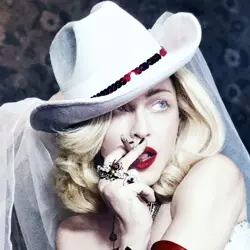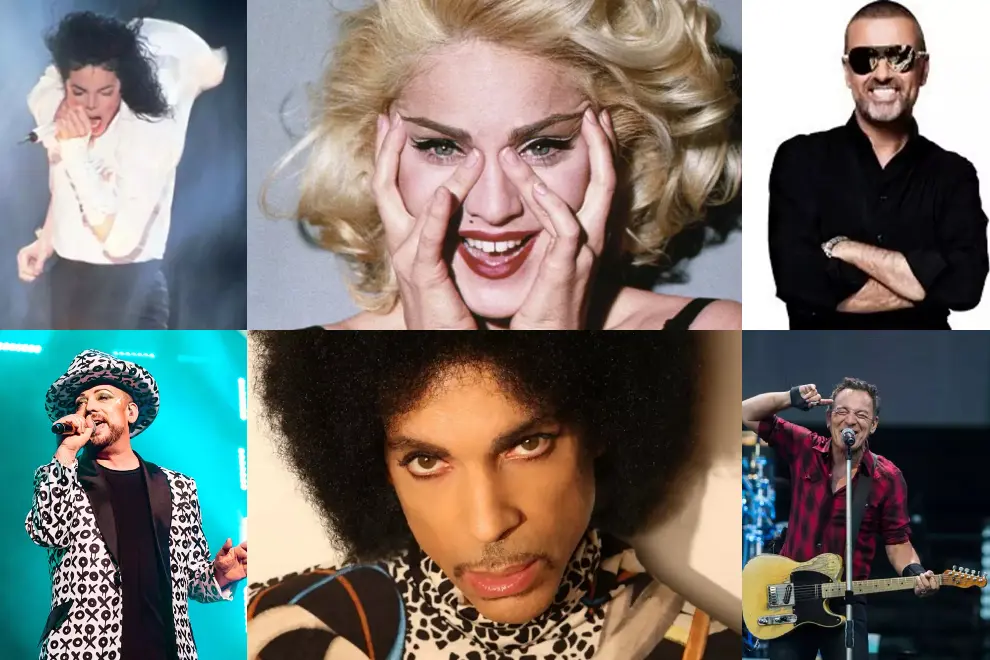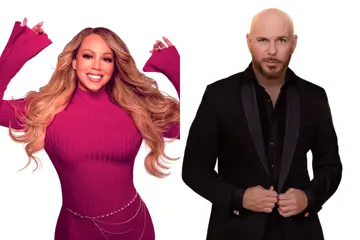 Madonna
MadonnaThere had been big music stars before. David Bowie. Elton John. Diana Ross. John Lennon. But a new type of music fame emerged 40 years ago – an all-pervading presence in the public consciousness thanks to multi-platinum albums packed with hit singles, buzz-worthy, big-budget music videos in constant rotation on MTV, a greater emphasis than ever before on image, and a cult of personality based either on savvy soundbites and media manipulation or a carefully cultivated mystique.
These were artists whose popularity was based on massive mega hits but whose fame extended well beyond the pop charts.
Michael Jackson
He’d been in the public eye since he was a child, but with 1982’s Thriller, Michael Jackson took his career to another level. Throughout 1983, a steady stream of singles like Billie Jean and Beat It propelled the album to record sales, with its status as the highest-selling album of all time confirmed by Guinness World Records in February 1984.
That same month, Jackson swept the Grammy Awards with eight wins from 12 nominations, including Record and Album of the Year. By early 1984, the game-changing music video for Thriller (which had been lifted as the album’s seventh and final single), coupled with the documentary Making Michael Jackson’s Thriller, had sold a million copies on VHS. At the same time, Thriller was selling a million copies a week.
But it wasn’t just industry accolades and persistently high sales figures that established Jackson as the King of Pop. It was his much-imitated look – the glove, the red leather jacket. It was his other-worldly dance moves and ability to shift from a timid, softly-spoken young man to a crotch-grabbing performer who exuded confidence onstage.
It was his breaking down of racial barriers and merging of musical genres - from the post-disco funk of P.Y.T. (Pretty Young Thing) to the Eddie Van Halen-featuring dance/rock of Beat It. In 1984, Michael Jackson was music’s biggest superstar – whether you listened to his music or not, it was impossible not to be bombarded with his image and sound.
Madonna
While Michael Jackson’s rise to music’s pinnacle had been more than a decade in the making, the Queen of Pop’s ascendancy was much more rapid. Madonna’s debut single, Everybody, had been released a couple of weeks before the lead single from Thriller and Jackson’s duet with Paul McCartney, The Girl Is Mine. But it wasn’t until the start of 1984 that her third single, Holiday, exploded, reaching #16 in the US that January and doing even better in Australia, peaking at #4 in May. Further hits – a re-promoted Burning Up, Borderline, and Lucky Star – followed, and Madonna was shaping up to be one of music’s brightest new stars.
What pushed her over the edge into superstar status was the release in late 1984 of Like A Virgin, the title track of her second studio album. As polished and catchy as her early dance/pop hits were, Like A Virgin was a pop culture moment that established Madonna’s provocateur credentials.
In a sign of things to come, the single was as much a talking point as it was a hit song. From its sexually charged lyrics to its glamorous Venice-set music video complete with an actual lion to that MTV VMA performance in a wedding dress, Like A Virgin set the standard for not only Madonna’s own career but those of countless other singers looking for a revamp. Heading into 1985, Madonna was perfectly positioned to further capitalise on her position as music’s most analysed and imitated female artist.
Prince
There’s nothing like a star vehicle movie to supercharge a performer’s career. After breaking through in a big way with 1983’s 1999 and Little Red Corvette, Prince became massive in 1984 thanks to Purple Rain and its accompanying soundtrack – a project he had actively demanded but which nobody wanted him to make.
Was he a star? Yes. Was he the lead in a studio film type of star? Few believed that. But self-confidence goes a long way and the part-concert movie, part-loose biography ended up getting the green light, allowing Prince to showcase the full range of his talents and rise to the status he already believed he occupied.
The movie’s story and acting were well received, as was the accompanying soundtrack, which was instrumental in moving Prince to that next stage of his career. His most commercial release to date, it consequently achieved career-best sales levels, with lead single When Doves Cry topping both the ARIA and Billboard charts and the album holding the US #1 spot for almost half a year.
The project’s title track, Purple Rain, the epic ballad that showed another side to the artist known for his tight funk material, became one of Prince’s signature tunes – and purple became his signature colour, with Prince dubbed the Purple One following the release of the film and due to his tendency to dress in the colour. The importance of Prince’s image cannot be understated. As musically prolific as he was, his identity, which defied traditional gender stereotypes in terms of what he wore and the way he talked about sex, was just as significant when it came to his emergence as a superstar.
George Michael
While some artists charged headlong towards their superstar destiny, others dipped their toe in the water. Take Wham! singer George Michael, who took his first steps towards a solo career in 1984 with the release of Careless Whisper, the first song credited to him and not the pop duo he’d launched a couple of years earlier with Andrew Ridgeley. (In North America, the song was credited to Wham! featuring George Michael.)
But while his career transition might have been tentative in that respect, there was nothing shy about the scale of success enjoyed by the saxophone-drenched ballad. Dating back to Wham!’s earliest demo, Careless Whisper helped the duo land their first record deal but hadn’t been released until the second album, Make It Big, which also contained Wake Me Up Before You Go-Go. Both songs topped charts around the world in 1984 and remain two of the decade’s most-played tracks.
Whether rocking short shorts and Day-Glo fingerless gloves out front of Wham! on Go-Go or despairing over having cheated on Careless Whisper, Michael established himself as one of the world’s finest vocalists, biggest heartthrobs, most skilled pop songwriters and most versatile performers in 1984.
That status was solidified by further hits Freedom, Everything She Wants, and future perennial festive favourite Last Christmas, as well as a prominent role on Band-Aid’s Do They Know It’s Christmas? He might not have been quite ready to launch fully into solo mode, but he was already a superstar whose future seemed assured. The question wasn’t if he’d embrace that solo destiny but when.
Boy George
Another British George had made headlines in 1983 and continued to be one of the most recognisable artists in the world in 1984 due to a combination of radio-friendly hit songs, his gender-blurring image and a ready supply of snappy one-liners in interviews.
Boy George’s oft-quoted remark about preferring a cup of tea to sex went a long way in making him more palatable to the mainstream than contemporaries like Divine and Dead Or Alive’s Pete Burns. Even in the more conservative US, he was a household name, with Karma Chameleon topping the Billboard Hot 100 in 1984 and Culture Club winning Best New Artist at that year’s Grammy Awards. Two years later, the singer was still so recognisable in the US that he guest starred in an episode of the family-favourite action series, The A-Team.
In Australia, Culture Club’s 1984 visit down under was greeted with mass hysteria, especially during an appearance at Adelaide’s Rundle Mall, and their tour received the type of reception reserved for superstars: the TV simulcast. And while the hits kept coming throughout the year – Victims, Miss Me Blind, It’s A Miracle, The War Song – Boy George’s celebrity stood aside from that, with the frontman earning himself a 60 Minutes interview with George Negus that explored his superstar quality.
Bruce Springsteen
Some artists peak straight out of the gate, while others take their time to hit their commercial stride. In 1984, Bruce Springsteen reached a wider audience than ever with his seventh album, Born In The U.S.A. The lead single, Dancing In The Dark, was the #1 song of 1984 in Australia despite never rising higher than #5 on the ARIA chart. It achieved that feat by being a constant presence on the chart – 53 weeks in the top 50, including 11 in the top 10, which was unheard of in the pre-digital age. It was one of seven ARIA top 50 hits from the album (seven top 10s in the US), which contrasted with only two minor top 40 hits prior to that.
Born In The U.S.A. was certainly Springsteen’s most pop album up until that point, with songs like Dancing In The Dark, I’m On Fire and Glory Days more accessible than earlier releases, but the album maintained his lyrical focus on real-world issues and problems, something that has often been overlooked by those who don't listen to the words of the title track, for example.
Hit singles and album sales aside, possibly the surest sign that Springsteen had reached superstar status was his nickname. Known as “The Boss” for years by his inner circle, that moniker slipped into the public consciousness and was adopted by his growing fanbase.
Yes, Springsteen's superstar status had nothing to do with flashy music videos or fashion-forward styling, but his everyman appeal was just as big a part of what made him so popular - and that was an image in its own right, as evidenced by the iconic blue jeans cover of Born In The U.S.A.






